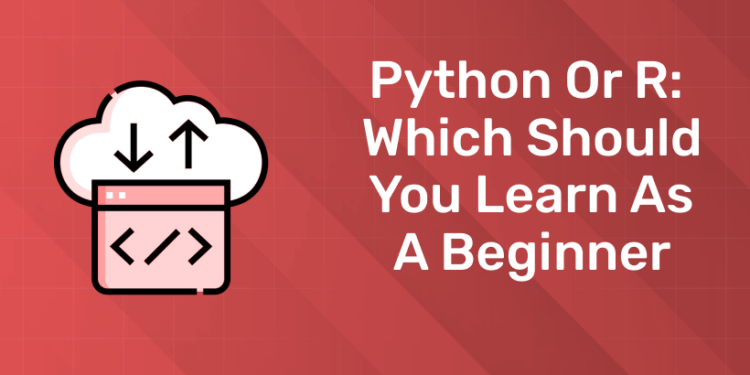Table of Contents
If you are reading this article, you are probably just starting your data science journey. You probably already know that learning how to code is an important step for any aspiring data professional. Additionally, you may have heard about the Python vs R debate and you may need help deciding which one to learn. If you are in this situation, don’t panic. Most data professionals have been in this situation before.
Python and R are the two most popular programming languages for data science. Both languages are well suited to any data science task you can think of. The Python vs R debate may suggest that you should choose Python or R. While this may be true for those new to the field, in the long run you will probably need to learn both two. Instead of viewing the two languages as mutually exclusive, you should view them as complementary tools that you can use together depending on your specific use case.
What makes R and Python perfect candidates for data science? In this article, we’ll explain what Python and R are used for, the key differences between R and Python, and provide some factors to consider when choosing the right language for your needs.
Now that we’ve established that Python and R are both good, popular choices, there are a number of factors that may influence your decision one way or the other.
Unlock Your Coding Potential with Our Python Programming Course – Enroll Today
Why choose Python?
Python is a general-purpose open source programming language used in many different software fields, including data science, web development, and gaming. Launched in 1991, Python is one of the most popular programming languages in the world, ranking first in several programming language popularity indices, such as the TIOBE Index and the PYPL Index.
One of the reasons why Python is so popular around the world is because of its user community. Python is supported by a large community of users and developers who ensure smooth development and improvement of the language, as well as the continuous release of new libraries designed for all uses.
Python is an easy to read and write language due to its high similarity to human language. In fact, high readability and interpretability are at the heart of Python’s design. For these reasons, Python is often considered a suitable programming language for beginners with no coding experience.
Over time, Python has gained popularity in the field of data science thanks to its simplicity and endless possibilities provided by hundreds of specialized libraries and packages that support all types of data science tasks , such as data visualization, machine learning, and deep data processing.
Why Choose R?
1: Which of the following data types is immutable in Python?
R is an open source programming language created specifically for statistical computing and graphics.
Since its first release in 1992, R has been widely adopted in scientific and academic research. Today, it remains one of the most popular analytics tools, used in both traditional data analysis and the rapidly growing field of business analytics. It ranks 11th and 7th in the TIOBE index and PYPL index, respectively.
Designed for statisticians, with R you can use complex functions in just a few lines of code. All types of statistical tests and models are available and easy to use, such as linear models, nonlinear models, classification and clustering. The enormous possibilities that R offers are mainly due to its huge community.
It has developed one of the richest collections of data science related packages. All are available through the Comprehensive R Archive Network (CRAN). Another feature that makes R particularly noteworthy is its ability to generate quality reports with data visualization support, and its frameworks are available to create interactive web applications. In this sense, R is considered by many to be the best tool for creating stunning graphics and visualizations.
R vs. Python: Key Differences
Now that you’re a little more familiar with Python and R, let’s compare them from a data science perspective to evaluate the similarities, strengths, and weaknesses their weakness.
Purpose
Although Python and R were created for different purposes (Python as a general-purpose programming language and R for statistical analysis), both are suitable for any data science task whether today. However, Python is considered a more versatile programming language than R, as it is also extremely popular in other software fields, such as software development, web development, and gaming.
Types of Users
As a general-purpose programming language, Python is the standard choice for software developers involved in data science. Additionally, Python’s focus on productivity makes it a more suitable tool for building complex applications.
In contrast, R is widely used in academia and in some industries, such as finance and pharmaceuticals. This language is ideal for statisticians and researchers with limited programming skills.
Learning curve
Python’s intuitive syntax is considered one of the closest programming languages to English. This makes it a very good language for new programmers, with a smooth and linear learning curve. While R is designed to easily perform basic data analysis in minutes, things get more difficult with complex tasks, and it takes R users longer to master the language.
Overall, Python is considered a good language for beginner programmers. R is easier to learn as a beginner, but the complexity of advanced features makes it more difficult to develop expertise.
Popularity
Although new programming languages, such as Julia, have been gaining momentum in data science recently, Python and R are still the absolute kings of the industry. However, in terms of popularity – always a very confusing concept – there is a very clear difference.
Python has always performed better than R, especially in recent years. Python ranks first in several programming language popularity indexes. This is due to the widespread use of Python in several software fields, including data science. In contrast, R is mainly used in data science, academia, and some industries.
Common Libraries
Both Python and R have a rich and robust ecosystem of packages and libraries designed specifically for data science. Most packages in Python are stored in the Python Package Index (PyPi), while R packages are typically stored in the Comprehensive R Archive Network (CRAN).
Below is a list of some of the most popular data science libraries in R and Python.
Unlock Your Coding Potential with Our Python Programming Course – Enroll Today
R Package:
- dplyr: This is a data manipulation library for R.
- Tidyr: a great package that will help you clean and organize your data.
- ggplot2: the perfect library for data visualization.
- Shiny: This is the ideal tool for creating interactive web applications directly from R.
- Caret: one of the most important libraries for machine learning in R.
Package Python:
- NumPy: provides a large collection of functions for scientific computing.
- Pandas: is great for data manipulation.
- Matplotlib: standard library for data visualization.
- Scikit-learn: is a Python library that provides many machine learning algorithms.
- TensorFlow: a widely used framework for deep learning.
Universal IDE
IDE, or integrated development environment, allows programmers to integrate different aspects of writing a computer program. These are powerful interfaces with built-in features that allow developers to code more efficiently. In Python, the most popular IDEs in data science are Jupyter Notebooks and its modern version, JupyterLab, as well as Spyder.
As for R, the most commonly used IDE is RStudio. Its interface is organized in such a way that users can view graphs, data tables, R code, and output results at the same time.
Python vs R: Comparison
Here is a table of the differences between R and Python:
|
R |
Python |
|
|
Purpose |
Very famous in academia and research, finance and data science |
Best-suited for many programming domains, including data science, web development, software development, and gaming |
|
First Release |
1993 |
1991 |
|
Type of Language |
General-purpose programming language |
General-purpose programming language |
|
Open Source? |
Yes |
Yes |
|
Ecosystem |
Nearly 19,000 packages available in the Comprehensive R Archive Network (CRAN) |
+300,000 available packages in the Python Package Index (PyPi) |
|
Ease of Learning |
R is initially easier to learn but becomes more difficult when using advanced features. |
Python is a beginner-friendly language with English-like syntax. |
|
IDE |
RStudio. Its interface is organized so that the user can view graphs, data tables, R code, and output all at the same time. |
Jupyter Notebooks and its modern version, JupyterLab, and Spyder. |
|
Advantages |
|
|
|
Disadvantages |
|
|
|
Trends |
11th in TIOBE and 7th in PYPL (December 2022) |
1th in TIOBE and 1th in PYPL (December 2022) |
R vs Python: Which language should you learn?
Check out the following resources and get started today!
- Extensive course catalog with over 380 data science courses including programming, statistics, visualization and more.
- Our Introduction to Python and Introduction to R courses can help you get started with the basics of both languages, helping you understand what you need to learn.
- A comprehensive, certified career path to go from zero to hero in data science.
- Check out our Python Fundamentals and R Programming courses.
- Subscribe to the DataFramed podcast.
- Check out our Python and Data Science Dashboard and Basics Dashboard about our R.
Unlock Your Coding Potential with Our Python Programming Course – Enroll Today










